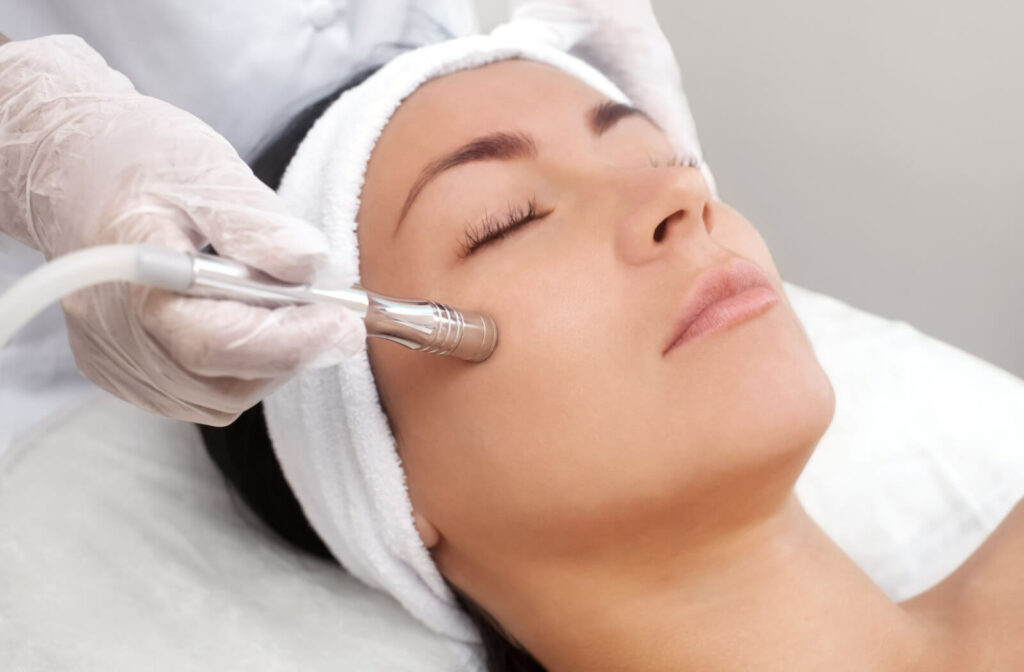Microdermabrasion is a popular cosmetic procedure that can help improve the appearance of the skin by exfoliating the outermost layer. It’s a minimally invasive treatment that can address various skin concerns, including hyperpigmentation, fine lines, and wrinkles.
If you’re considering microdermabrasion, you may be curious about how often you should schedule your treatments for optimal results.
The number of sessions you need will depend on the severity of your skin concerns and expectations. With the help of a professional, you can determine a frequency based on individual needs.
What Is Microdermabrasion?
Microdermabrasion is a physical type of exfoliation using a special applicator with a vacuum-like suction on the skin’s surface to remove the outer layer, including dead skin cells and impurities. This process stimulates cell turnover and promotes the growth of new, healthier skin.
Microdermabrasion is generally safe for most skin types and colors without any downtime, making it a convenient option for those with busy schedules. However, it’s important to note that everyone’s skin is unique, and individual responses to the treatment may vary.
Microdermabrasion can address the following skin concerns:
- Fine lines and wrinkles
- Hyperpigmentation, age spots, or brown spots
- Enlarged pores and blackheads
- Acne and acne scars
- Stretch marks
- Dull skin complexion
- Uneven skin tone and texture
- Sun damage
Microdermabrasion Procedures
Microdermabrasion is an in-office procedure that can take 10–15 minutes, depending on the treatment area. Since it’s non-nvasive, a numbing agent is not required.
The process can feel rough or gritty on the skin and with some possible tugging due to the suction, but it is generally a comfortable procedure. The process can involve a few different methods.
Diamond-Tip Microdermabrasion
This procedure exfoliates dead skin cells and suctions them. The more pressure applied, the deeper the abrasion. It is gentle enough for sensitive facial areas like the eyes.
Crystal Microdermabrasion
This procedure uses a crystal-emitting handpiece to gently spray on fine crystals to exfoliate the outer layers of the skin and suction them away immediately after treatment to reveal overall skin tone and texture. Crystals used can include aluminum oxide and sodium bicarbonate.
Hydradermabrasion
Hydradermabrasion is a newer method that combines crystal-free exfoliation and infusion of products into the skin. It’s believed to stimulate collagen production and maximize blood flow to your skin.
Recommended Frequency for Microdermabrasion
The results of microdermabrasion are not permanent. For this reason, you may need repeat treatments.
The frequency at which you should get microdermabrasion depends on several factors, including your skin type, specific concerns, and the advice of a professional. Discuss your skincare goals and any existing skincare routines and products you use during your consultation.
This information can help your doctor tailor the treatment frequency and make appropriate recommendations to enhance your skincare routine. Individuals can receive treatments weekly, every 2 weeks, or monthly.
To see the results from reduced signs of aging, you may need between 5 and 16 treatments. Most professionals may recommend spacing out their microdermabrasion treatments every 2 to 4 weeks. Initial treatments can jumpstart rejuvenation, visibly improving your skin’s texture and appearance.
Spacing out treatments in the recommended time frame can allow enough time for your skin to recover between sessions and reduce the risk of irritation. While microdermabrasion is gentle, it can still cause temporary side effects, such as:
- Redness
- Mild tenderness
- Swelling
- Sensitivity
- Mild peeling
- Minor bruising
These side effects usually go away within a few minutes after treatment. There is little to no downtime after microdermabrasion. However, if you experience side effects, they typically disappear after a few hours, and your skin should recover in time for your upcoming treatment.
You’ll likely need a moisturizer to keep the skin hydrated after treatment. Your skin can be more sensitive for a few days after treatment, so it’s best to use sun protection to protect your skin.
Microdermabrasion may not be suitable for everyone. If you scar easily or have cold sore breakouts, speak to your doctor or skin specialist before starting treatment.
Maintenance Treatments
Once you’ve completed the initial series of treatments, you can transition to a maintenance schedule. Maintenance treatments help to sustain the results achieved during the initial series and promote ongoing skin health.
For most individuals, your doctor or skin specialist can help to design a plan for periodic maintenance treatments. However, it’s also essential to be aware of your skin and adapt the frequency as needed.
Skin Rejuvenation Based on Your Needs
Microdermabrasion can be a valuable tool in pursuing healthy, radiant skin. While the frequency of treatments may vary depending on individual factors, a general guideline is to schedule sessions every 2 to 4 weeks.
Following an initial series of treatments, you can work with your doctor to determine the optimal frequency for your specific needs and create a skincare routine that supports your overall skin health and well-being.
If you’re interested in learning more about microdermabrasion, book an appointment with Eye Lab to learn about our range of treatments and skin care products.





